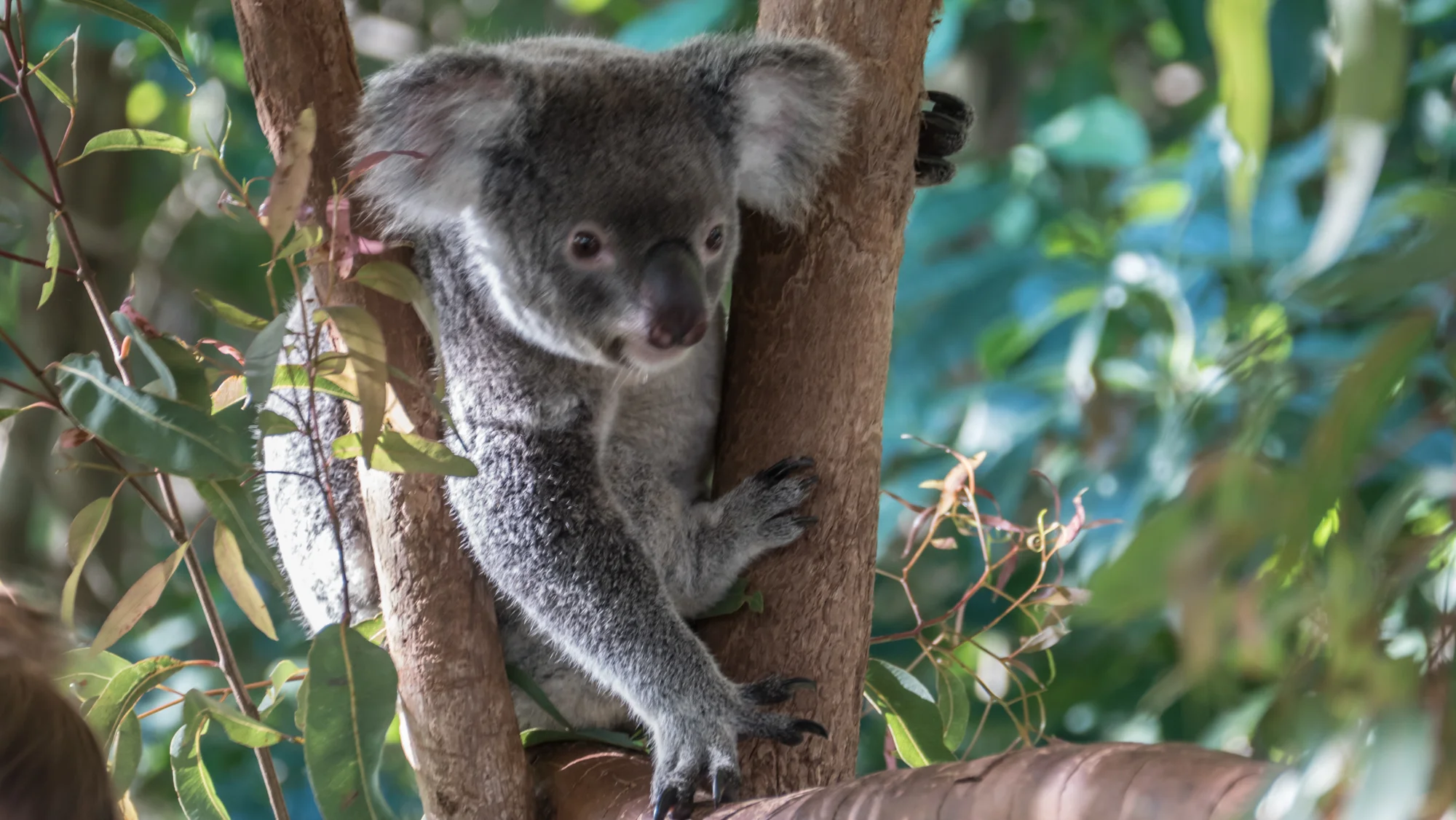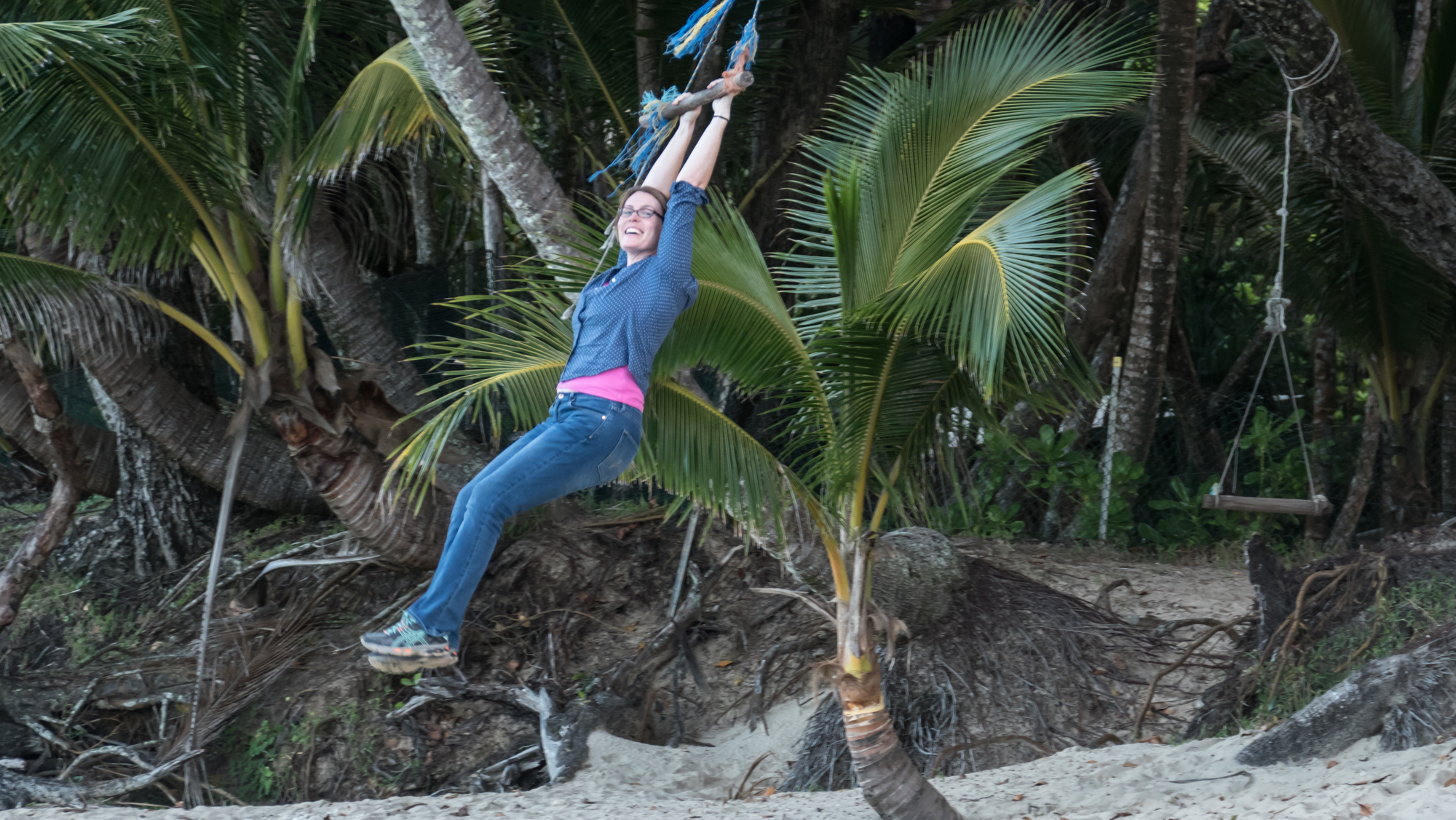Down Under: Green Island and Daintree Rainforest
In May, 2016 we joined Eric, Jodi and the grandkids for a trip to Australia. The trip largely retraced a trip we had taken in 1991 when we were on sabbatical in Brisbane and Eric was a teenager. We went to the Great Barrier Reef and Daintree Rainforest area. We flew to Cairns and used that as a base for a trip to Green Island, as well as to the Daintree rainforest and the Atherton Tablelands.
Rainbow lorikeets on the beach in Cairns
Rainbow lorikeets
Following a family tradition, here we are posing in front of the wrong boat.
Green Island
Green Island is one of the few true Barrier reef islands, that is, the island is itself part of the Great Barrier Reef. Many of the other islands along the northeast shore of Australia may be close to the Great Barrier Reef but are not part of the reef. The advantage of being a Barrier reef island is that the reef is right off-shore. In theory one can simply swim out to see the reef. However, over the past 20 years the reef has been dying due to human activities and climate change so that most of the reef directly accessible from Green Island is dead or dying so few fish can be seen.
To get the full Great Barrier reef experience, we also stayed on the Green Island resort for 3 days. Most tourists come to the island on day trips from Cairns so the island is very crowded until the tour ships return in the afternoon. Many of the tour boats have large groups of Chinese tourists, who invariably have a few individuals who behave badly. For example, we observed Chinese who blithely walked on the coral while wading offshore, despite the entreaties of the lifeguards not to do so because it kills the coral. They would act like they didn’t understand English. Speaking to the lifeguards, they were very frustrated with the Chinese but they also realized that their job depended upon these tour boats continuing to visit. Of course the destruction of the reef has been going on for much longer than the recent wave of Chinese tourists so there are many parties to blame for this deteriorating situation.
After the last tour boat leaves in the afternoon, the environment becomes much more peaceful and tranquil. While most people come to the island to dive or snorkel, they have a number of other sites of interest to kids, including an enclosure where they keep Cassius, reputedly the largest saltwater crocodile in captivity. Of course, the daily feeding is a big event.
Sea turtle as seen from the pier
Reef heron arriving early for lunch
Cassius, the world’s largest crocodile in captivity, working for lunch
Manta ray as seen from the pier
Black reef heron
Red banded rail, a persistent pest at the resort
Glass bottom boat ride
Giant clam from the glass bottom boat
Black reef heron
Snorkeling on Green Island
This trip to Australia was rather suddenly planned and came about because of two factors: one, Eric found some very cheap tickets for his family to fly to Oz and back (we did not decide fast enough so we did not get the big discount) and two, there were a spate of articles in the news about how the Great Barrier Reef was dying. So Eric wanted the kids to see the reef before there was little to see. We had taken Eric to Green Island in 1983 when he was 5 years old and indeed, the reef around the island had deteriorated considerably since then, at least in our fading memory of that trip. While there are fish around the dying reef near the island, one needs to take a short boat ride to the ‘outer’ reef to see the really colorful spectrum of fish. Both Josh and William quickly became very proficient at snorkeling and had no fear of going out into the deeper outer reef, where the only relief from snorkeling was to come back to the boat.
Josh says “Hi”
Green sea turtle spotted while snorkeling
Parrot fish
The current can be quite strong in some parts of the reef
Giant clam
Giant clam with its jaws open. Normally they close as soon as they detect a shadow over it.
Sea cucumber
Snorkeling buddies
Daintree rainforest
Following our three night stay on Green Island, we returned to Cairns and drove up to the Daintree rainforest where we had reservations in the same hostel (Crocodylus) that we stayed in in 1992. The hostel had changed hands and went through some transformations in the intervening years but it was basically similar to what we experienced almost 30 years ago. One of the interesting activities that we did at the hostel, which we also did in 1992, was to go on a guided night walk through the rainforest. The guide was quite knowledgeable about the various animals that we encountered during the walk, mostly large spiders with their webs.
During the day we drove to the nearby beach at Cow’s Bay. There was a small fresh water stream that emptied into the bay and the boys enjoyed playing in the sand and jumping into the fresh water. A day or two later we heard stories of a woman who was eaten by a large saltwater crocodile on Thornton beach just about 4-5 miles north of where we were. She was with another lady who witnessed the attack and for some unknown reason the ladies were on the beach and in the water at night, which is a prime time to encounter the fearsome salties. Australia has a reputation for harboring a relatively large number of ‘nasties’ or dangerous animals and the saltwater crocodile probably heads this list as there are always a number of fatalities each year, mostly from the northern tropical area where we were. The freshwater crocodiles are smaller and much less aggressive, but they are found in inland lakes. In addition the other nasties include several of the most venomous snakes on the planet, sharks who take a few swimmers every year off the beaches, venomous spiders, some of whom are reputed to make their homes under toilets, box jellyfish, and cone shells. The natives love to tease tourists with stories about these various nasties so one never knows what to believe.
Cone shells are innocuous looking shells that one might find on the beach and pick up because they are beautiful looking. They have a harpoon tipped with a toxin which is now called conotoxin and is so effective that fish speared with the harpoon as they wander near the shell in the ocean die almost instantly, so that the shell can make its way to the fish to devour it. A neuroscientist studying the toxin came up with a dose-response curve in which the response parameter was the distance that a mouse would run along a narrow platform before keeling over dead when injected with some dose of the toxin. In humans one sting can be lethal.
The year that we were on sabbatical in Brisbane, I was bicycling home one night near dark and I swerved to avoid a large branch in the street. As I passed the branch, though, it moved. When I went back to inspect what it was, I realized that it was a very large snake, probably a python though I admit to being so surprised that I didn’t do a thorough examination. These snakes are not venomous and generally not dangerous to humans, though their size is daunting, but are known to sometimes take small dogs from backyards.
Spider web
In case you get stung by jellyfish
Intricate beach art by sand bubbler crabs
Beach art
Beach art
Net casting spider - instead of putting up a web and waiting for prey to get caught in it, this spider has a web (in light blue) that it drops over the prey to ensnare it.
Golden orb spider
Fun at Cow Bay
Golden orb spider
Fun at Cow Bay
Fun at Cow Bay
Fun at Cow Bay
Hartley’s wildlife refuge
While we saw a few kangaroos in the fields as we were driving around, we didn’t really see many of the iconic Australian fauna for which it is so aptly famous. To take care of this shortcoming, we spent an afternoon at a wildlife refuge not far from Cairns where the kids had the opportunity to see many of the unusual animals of Oz. There was a large fenced area with kangaroos and wallabies that were happy to eat from your hand. Michael, the youngest had been feeling left out in some of the week’s activities (e.g. he wasn’t able to swim so he couldn’t go out on the expedition to the outer reef), loved feeding and petting the wallabies/kangaroos. They had a large cohort of koala bears, and at least at the time that we were there, many of them were not sleeping, which is how one usually sees them in zoos. William was the only one who wanted to hold a koala and have his picture taken with it, for a price, of course. They had an extended small lake that housed crocodiles which you could see from the short boat ride. The kids loved the wildlife and they actually came back to spend another morning there after we left and before their afternoon flight home.
Michael with friend
William with friend
Wallaby with Joey
William with friend
William with friend
Atherton Tableland
On our last day we drove up to the neighboring Atherton Tableland, a sparsely populated area with a number of quaint towns and attractions, one of which is a gigantic strangler fig tree known as the Cathedral fig. Another reason for coming here is that according to the guide books, there is a stream, Peterson creek, where one can see duck-billed platypuses in the wild. Sighting a platypus in the wild was the number one item on William’s list of things to see in Australia so he was very keen on this expedition. I told him not to get his hopes up as this is a rare event since most Australians have never seen one in the wild. In Yungaburra there was even a platypus viewing platform at Peterson Creek but there were none to be seen when we were there. However, as we hiked along the stream bed, both William and Eric did indeed see a platypus swimming in the water, though there wasn’t any photographic evidence. Nonetheless, William was overjoyed.
Strangler Cathedral tree
Strangler Cathedral tree
Strangler Cathedral tree
Stay awhile plant
Searching for the elusive platypus at Peterson creek
Marsupial possum with young
Marsupial possum with young
Giant staghorn ferns
Josh and William at Dinner falls in Mt Hypipamee Nat'l Park
A vertical panorama of the deep volcanic Hypipamee crater in the Atherton Tableland
Please note: All text and photos are copyrighted to Tom Yin. You are welcome to share the URL, however re-production of text or photos is not permitted. If you would like to feature this story, contact me and I would be happy to provide you with details, photos, text etc. Thanks!




















































































